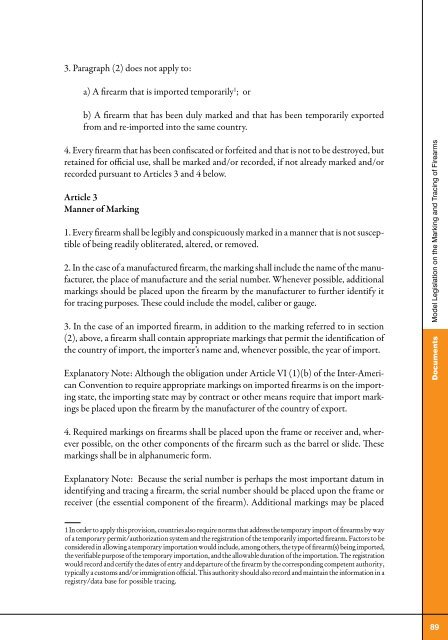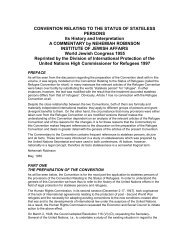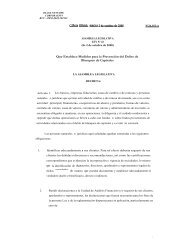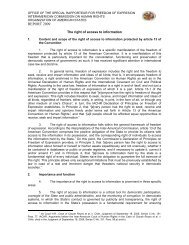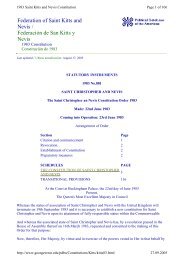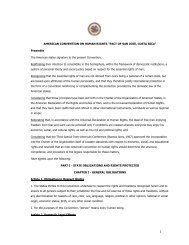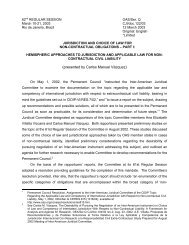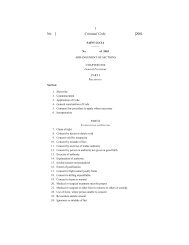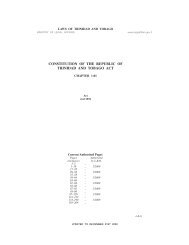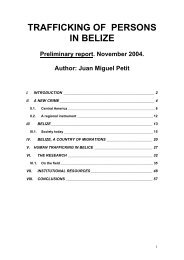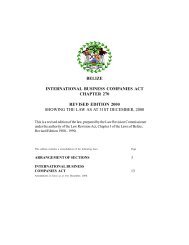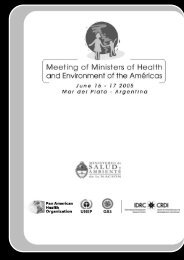Documentos Claves de la OEA sobre Seguridad, Vol. III CIFTA
Documentos Claves de la OEA sobre Seguridad, Vol. III CIFTA
Documentos Claves de la OEA sobre Seguridad, Vol. III CIFTA
Create successful ePaper yourself
Turn your PDF publications into a flip-book with our unique Google optimized e-Paper software.
3. Paragraph (2) does not apply to:<br />
a) A firearm that is imported temporarily 1 ; or<br />
b) A firearm that has been duly marked and that has been temporarily exported<br />
from and re-imported into the same country.<br />
4. Every firearm that has been confiscated or forfeited and that is not to be <strong>de</strong>stroyed, but<br />
retained for official use, shall be marked and/or recor<strong>de</strong>d, if not already marked and/or<br />
recor<strong>de</strong>d pursuant to Articles 3 and 4 below.<br />
Article 3<br />
Manner of Marking<br />
1. Every firearm shall be legibly and conspicuously marked in a manner that is not susceptible<br />
of being readily obliterated, altered, or removed.<br />
2. In the case of a manufactured firearm, the marking shall inclu<strong>de</strong> the name of the manufacturer,<br />
the p<strong>la</strong>ce of manufacture and the serial number. Whenever possible, additional<br />
markings should be p<strong>la</strong>ced upon the firearm by the manufacturer to further i<strong>de</strong>ntify it<br />
for tracing purposes. These could inclu<strong>de</strong> the mo<strong>de</strong>l, caliber or gauge.<br />
3. In the case of an imported firearm, in addition to the marking referred to in section<br />
(2), above, a firearm shall contain appropriate markings that permit the i<strong>de</strong>ntification of<br />
the country of import, the importer’s name and, whenever possible, the year of import.<br />
Exp<strong>la</strong>natory Note: Although the obligation un<strong>de</strong>r Article VI (1)(b) of the Inter-American<br />
Convention to require appropriate markings on imported firearms is on the importing<br />
state, the importing state may by contract or other means require that import markings<br />
be p<strong>la</strong>ced upon the firearm by the manufacturer of the country of export.<br />
4. Required markings on firearms shall be p<strong>la</strong>ced upon the frame or receiver and, wherever<br />
possible, on the other components of the firearm such as the barrel or sli<strong>de</strong>. These<br />
markings shall be in alphanumeric form.<br />
Exp<strong>la</strong>natory Note: Because the serial number is perhaps the most important datum in<br />
i<strong>de</strong>ntifying and tracing a firearm, the serial number should be p<strong>la</strong>ced upon the frame or<br />
receiver (the essential component of the firearm). Additional markings may be p<strong>la</strong>ced<br />
1 In or<strong>de</strong>r to apply this provision, countries also require norms that address the temporary import of firearms by way<br />
of a temporary permit/authorization system and the registration of the temporarily imported firearm. Factors to be<br />
consi<strong>de</strong>red in allowing a temporary importation would inclu<strong>de</strong>, among others, the type of firearm(s) being imported,<br />
the verifiable purpose of the temporary importation, and the allowable duration of the importation. The registration<br />
would record and certify the dates of entry and <strong>de</strong>parture of the firearm by the corresponding competent authority,<br />
typically a customs and/or immigration official. This authority should also record and maintain the information in a<br />
registry/data base for possible tracing.<br />
Mo<strong>de</strong>l Legis<strong>la</strong>tion on the Marking and Tracing of Firearms<br />
Documents<br />
89


